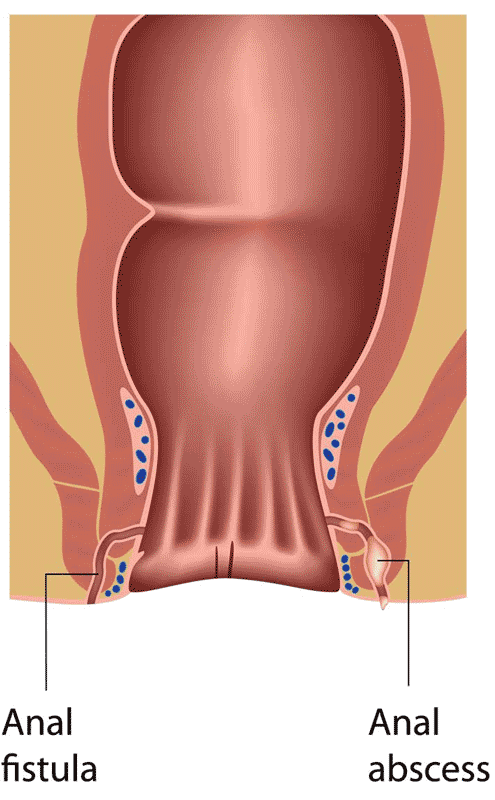Conditions – Anus
Anal fistula
A fistula is an abnormal tubular connection between two organs or an organ and the skin. In the case of anal fistula an abnormal tunnel connection forms between the inside of the back passage or the end of the bowel and the skin on the outside. The most common cause for that is an infection developing within blocked glands in the back passage forming an abscess which then drains with pus through the back passage muscle (sphincter) to the skin outside causing a fistula. Conditions such as Crohn’s disease may be associated with complex or persistent fistulae and sometimes cancer may be present in this way.

Symptoms
An anal fistula is usually preceded by a short period of pain and swelling sometimes associated with temperature around the back passage (peri-anal abscess). This subsequently resolves by draining itself or it is surgically drained through the skin. In the weeks and months that follow a residual small opening remains around the back passage which is sometimes painful and may swell up on and off discharging pus or blood and staining the underwear. Sometimes the fistula may completely block leading to the formation of further abscesses.
Diagnosis
Your history will be taken carefully and you will be examined in the area to establish the diagnosis and exclude other conditions. A proctoscopy will be performed unless it is very painful and your doctor may be able to diagnose you only by observation. Depending on the findings and your symptoms, your doctor may need to request a flexible sigmoidoscopy or colonoscopy to rule out any other condition further up the bowel or may request some imaging investigations in the form of an MRI, endoanal ultrasound or CT scan. An examination of the area while you are anaesthetised (Examination under anaesthesia – EUA) may also be sometimes required to establish the diagnosis.
Treatment options
The treatment options for anal fistula will depend on the underlying cause. It will also depend on whether the fistula crosses through the circular back passage muscle (sphincter) and at what level. An initial examination under anaesthesia (EUA) may be required to establish that with the insertion of a draining seton to drain any residual infection. The surgical options then include fistulotomy (laying open of the fistula), the insertion of a fistula plug or paste, performing a LIFT procedure or an advancement flap.
In cases of Crohn’s disease an EUA is required with insertion of a drainage seton to drain any infection. Medication can then be given by your gastroenterologist to control the disease which can then potentially resolve the fistulae.
The specifics and rationale for your individualised treatment will be discussed with you at the clinic.
Choose Category
– Haemorrhoids
– Anal fissure
– Anal fistula
– Anorectal abscess
– Rectal prolapse
– Faecal incontinence
– Anal pruritus
Need to contact us or book an appointment?
Disclaimer
The information relating to general and colorectal disorders and their treatments given on this website is not complete and is not intended as a substitute for a consultation with your doctor. Always seek medical advice from your doctor before making a decision about any of the conditions and/or treatments mentioned on this website.
© Dr Georgios Markides
Contact Information
You can always contact our Clinic for booking appointments and other useful information:
Dr. Georgios Markides,
Consultant General & Colorectal Surgeon
APEX Building, 47 Andreas Avraamides Str., 2024 Strovolos, Nicosia, Cyprus
+357-22-282008
